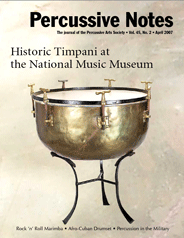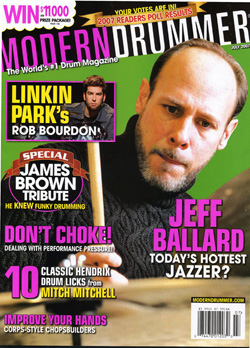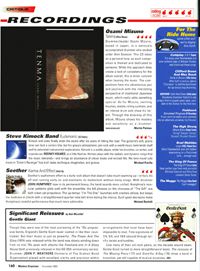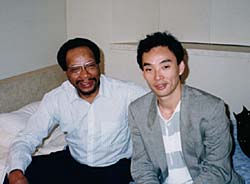|
|
|
|
|
Profile
|
|
|
Osami
Mizuno (Drums & Percussion instruments)
Official website: http://www.osami.net
Director of SHOOTINGSTAR STUDIO Manager of Music
& Environment Division, Office Mizuno
 Osami
Mizuno was blown away by Tony Williams's overwhelming
power and virtuosity, and went on to Berklee
College of Music to study with legendary mentor/drummer
Alan Dawson, who had taught Tony Williams. After
returning to Japan he played with many musicians
from various genres. While performing as a drummer,
he established the Alan Dawson Drum School with
the permission of Florence Dawson, in order to
pass on Alan Dawson's method to younger drummers.
Since then our mentor Alan Dawson gave us master
classes every time he came to Japan. On September
2, 1986, the great Tony Williams gave us a special
drum clinic. Subsequently, many of Osami's close
friends such as Steve Smith, Harvey Mason, John
Blackwell, and Billy Hart gave special master
classes. On November 23, 2003, Osami held a "Tribute
to Ron Spagnardi & Taku Kawai" with
a special solo performance by Horacio "El
Negro" Hernandez. In 2002 he established
the Dawsonisms School Division based on the Alan
Dawson Drum School in Japan, and in 2004 launched
the Dawsonisms Label Division (now known as the
Office Mizuno label). In 2005 Osami released
his first solo CD, "TENMA". It received
a "4 drum set" rating from Modern Drummer
Magazine where they said, "Through the diversity
of this album, Mizuno shows his mastery and sensitivity
as a drummer." Osami
Mizuno was blown away by Tony Williams's overwhelming
power and virtuosity, and went on to Berklee
College of Music to study with legendary mentor/drummer
Alan Dawson, who had taught Tony Williams. After
returning to Japan he played with many musicians
from various genres. While performing as a drummer,
he established the Alan Dawson Drum School with
the permission of Florence Dawson, in order to
pass on Alan Dawson's method to younger drummers.
Since then our mentor Alan Dawson gave us master
classes every time he came to Japan. On September
2, 1986, the great Tony Williams gave us a special
drum clinic. Subsequently, many of Osami's close
friends such as Steve Smith, Harvey Mason, John
Blackwell, and Billy Hart gave special master
classes. On November 23, 2003, Osami held a "Tribute
to Ron Spagnardi & Taku Kawai" with
a special solo performance by Horacio "El
Negro" Hernandez. In 2002 he established
the Dawsonisms School Division based on the Alan
Dawson Drum School in Japan, and in 2004 launched
the Dawsonisms Label Division (now known as the
Office Mizuno label). In 2005 Osami released
his first solo CD, "TENMA". It received
a "4 drum set" rating from Modern Drummer
Magazine where they said, "Through the diversity
of this album, Mizuno shows his mastery and sensitivity
as a drummer."
Publications;
Alan Dawson Drum Method, Vol. 1 (Ongaku-no-Tomo
Sha, 1998)
Alan Dawson Drum Method, Vol. 2 (Ongaku-no-Tomo
Sha, 1999: contribution by Steve Smith)
Osami also contributed a "Rudimental Symposium"
column to Modern Drummer magazine (April to July,
2001); founder & chief editor Ron Spagnardi,
who was also one of Alan's students, gave him
the wonderful name "Dawsonisms."
.jpg) Vinnie
and I first talked about making an instruction
book about this Superimposed Metric Mudilation
4 years ago. And now (at last!) here it is!! Vinnie
and I first talked about making an instruction
book about this Superimposed Metric Mudilation
4 years ago. And now (at last!) here it is!!
The book
"Illusions in Rhythm for Drum set"
>>click
here

He has endorsed TAMA Drums, PAISTE Cymbals,
and PRO-MARK Drumsticks exclusively. Also under
the auspices of SHURE Microphones,
|
|
|
 |
Percussive
Arts Society
in the 'April' issue of Percussive Notes.
'Illusions in Rhythm for Drum
Set' by Osami Mizuno
Difficulty Rating Scale: Advanced
Publisher: Osami Office
Drumset players looking for
a challenge will certainly find one in this new
book by Osami Mizuno in collaboration with Vinnie
Colaiuta. Illusions in Rhythm is really all about
developing the ability to perform hemiolas and
superimpose them over other rhythms. As Mizuno
makes clear, the concepts and exercises were
inspired by his study with Alan Dawson as well
as his exposure to Tony Williams.
The exercises begin with simple hemiola groupings,
such as grouping triplets into groups of four
notes and moving them across the barline. Five-and
seven-note groupings are also explored. Soon,
more complex combinations are presented in various
musical contexts. The concepts are applied to
several different styles including swing, samba,
shuffle and rock/funk grooves. All the exercises
are written in a clear format that shows how
all the notes line up.
This book is for serious drummers who desire
to add a new dimension to their playing. As with
all good drumset books, it is open-ended so students
can further develop the concepts and techniques.
------------------Tom Morgan
|
|
|
------------------------------------------------
|
|
|
 |
MODERN
DRUMMER JULY 2007 issue
MULTI-MEDIA
ILLUSIONS IN RHYTHM FOR DRUM
SET BY OSAMI MIZUNO
BOOK LEVEL : ADVANCED
$26.00 (INCLUDES SHIPPING FROM JAPAN)
Japanese drummer/educator Osami
Mizuno credits Alan Dawson, Tony Williams, and
Vinnie Colaiuta (Vinnie also collaborated and
contributed to this book) as his inspiration
for this 83-page collection of advanced drumset
exercises based on teachings of Dawson and advancing
into Colaiuta's concepts of " Superimposed
Metric Modulation." The idea is to layer
one pulse, or time feel, on top of an existing
pulse to create the illusion of the time shifting,
or creating an imaginary change in time signatures.
The exercises (mostly rock, Latin, and shuffle)
are well written and fairly well explained, but
such advanced concepts really need a sound reference
(CD, DVD, etc.) to fully grasp the complex rhythms.
As is, this book would be best studied with the
help of a knowledgeable private instructor. (
www.osami.net) Mike Haid
|
|
|
------------------------------------------------
|
|
|
.jpg) |
DRUMHEAD
May - June 2007
REVIEWS P 102
Illusions in Rhythm for Drum
Set
- Osami Mizuno
In collaboration with Vinnie Colaiuta
Four years after talking about
writing
this book together, Osami Mizuno,
in collaboration with Vinnie Colaiuta,
has written an instructional book on
"Superimposed Metric Modulation. "Osami
explains the method and idea for the book this
way:
Superimposed Metric Modulation was a new drumming
method introduced by an industry magazine for
American percussion by Vinnie Colaiuta, who has
been one of my best friends since we both studied
with Alan Dawson in the mid 70s.
Soon after, he came to Japan and demonstrated
this method using a sequencer. But at that time
most of the people couldn't understand what he
was doing. Briefly, Superimposed Metric Modulation
is a kind of "key change" in rhythms.
Modulation is quite common for melody instrument
players, but it's not for drummers…..maybe you
can say it's avant-garde. But in fact, this concept
originally came from great jazz innovators such
as "Papa" Jo Jones, Max Roach, and
our hero Tony Williams.
To make it his own method, Vinnie made this concept
more rock-friendly. Today more and more drummers
such as Steve Smith, Virgil Donati and Horacio"El
Negro"Hernandez are using this concept.
That means the "key change" in rhythms
is no longer a maniac technique, and is now becoming
popular among durmmers.
---- To order : www.osami.net ---
DH: Osami Mizuno has done it
!
Illusions in Rhythm for Drum Set is actually
very easy to understand and follow.He takes away
much of the mystery of metric modulations and
superimposed rhythms, making them less firghtening
and more approachable than ever.
Absolutely worth it's very reasonable price.
|
|
|
----------------------------------------------------
|
|
|
 "Drummer
/ leader Osami Mizuno, "Drummer
/ leader Osami Mizuno,
based in Japan, is a seriously accomplished
drummer who studied under Alan Dawson. This CD
takes on a personal tone, as each composition
is themed and dedicated to someone. While this
approach does create a lack of consistency for
the album overall, this is minor
concern when hearing the music. The compositions
here mix adventurous jazz
and jazz/rock with the intereting perspective
of traditional Japanese
music, which really adds something special.
As for Mizuno, swirling brushes, stately rolling
cymbals, and an intense
drum solo show his talent. Through the diversity
of this album, Mizuno shows
his mastery and sensitivity as a drummer."
By Martin Patmos
 TENMA TENMA
Osami Mizuno
With this album TENMA, I have tried to create
a borderless world based on
the traditions of different cultures, by collaborating
with great musicians
from around the world. The various musical elements
have been modified and
blended with care, in an attempt to achieve a
result that is new and
different.
I hope you enjoy it.
|
|
|
|
Alan & I
Preface.
Mr. Alan Dawson will always be remembered not
only for histalent, but for the skills he has
taught to drummers of today.
Alan Dawson was born on July 14, 1929 in Marietta,
Pennsylvania. Alan had recorded with such greats
as Booker Ervin, Dave Brubeck,Lionel Hampton,
Quincy Jones, George Benson, Clifford Brown,Jaki
Byard, and many more. He had traveled extensively
in Japan,as well as to Europe, Australia, and
throughout Asia. In 1957, he started his teaching
career at The Berklee College of Music and had
taught for over 18 years. In 1975, Alan had injured
himself by rupturing a his disc in his back and
had required surgery. He had stopped his teaching
career at Berkee and continued teaching from
his home.
His teaching method is legendary and was considered
a fruit from his actual playing experience in
the field of education. By solving concerns and
personal problems in drumming, which had affected
almost over 70% of drummers, this was resolved
by following hiscore teaching called the "Alan
Dawson Technique."
When he went on concert tours in Japan, as a
member of the100 Golden Fingers Concert and Great
Jazz Trio, he spent his private time giving lessons.
Right before departing for Japanin May 1995,
he learned that he had leukemia. After a longstruggle
with this disease, he died of leukemia at home
onFebruary 23, 1996 at the age of 66.
It always made me wonder what made him always
have thisperpetual smile. What made him always
so happy and glad? Fighting through his illness
for an extended period of timewith medication,
he said that he kept on saying, "This could
have helped Mr. Shelly Manne."
Alan taught Tony Williams, Keith Copeland, Steve
Smith,Harvey Mason, Vinnie Colaiuta, John Robinson,Kenny
Aronoff, and many, many others.
|
|
|
|
|
|
|
|
|
|
|
|


.jpg)
 TENMA
TENMA Osami
Mizuno was blown away by Tony Williams's overwhelming
power and virtuosity, and went on to Berklee
College of Music to study with legendary mentor/drummer
Alan Dawson, who had taught Tony Williams. After
returning to Japan he played with many musicians
from various genres. While performing as a drummer,
he established the Alan Dawson Drum School with
the permission of Florence Dawson, in order to
pass on Alan Dawson's method to younger drummers.
Since then our mentor Alan Dawson gave us master
classes every time he came to Japan. On September
2, 1986, the great Tony Williams gave us a special
drum clinic. Subsequently, many of Osami's close
friends such as Steve Smith, Harvey Mason, John
Blackwell, and Billy Hart gave special master
classes. On November 23, 2003, Osami held a "Tribute
to Ron Spagnardi & Taku Kawai" with
a special solo performance by Horacio "El
Negro" Hernandez. In 2002 he established
the Dawsonisms School Division based on the Alan
Dawson Drum School in Japan, and in 2004 launched
the Dawsonisms Label Division (now known as the
Office Mizuno label). In 2005 Osami released
his first solo CD, "TENMA". It received
a "4 drum set" rating from Modern Drummer
Magazine where they said, "Through the diversity
of this album, Mizuno shows his mastery and sensitivity
as a drummer."
Osami
Mizuno was blown away by Tony Williams's overwhelming
power and virtuosity, and went on to Berklee
College of Music to study with legendary mentor/drummer
Alan Dawson, who had taught Tony Williams. After
returning to Japan he played with many musicians
from various genres. While performing as a drummer,
he established the Alan Dawson Drum School with
the permission of Florence Dawson, in order to
pass on Alan Dawson's method to younger drummers.
Since then our mentor Alan Dawson gave us master
classes every time he came to Japan. On September
2, 1986, the great Tony Williams gave us a special
drum clinic. Subsequently, many of Osami's close
friends such as Steve Smith, Harvey Mason, John
Blackwell, and Billy Hart gave special master
classes. On November 23, 2003, Osami held a "Tribute
to Ron Spagnardi & Taku Kawai" with
a special solo performance by Horacio "El
Negro" Hernandez. In 2002 he established
the Dawsonisms School Division based on the Alan
Dawson Drum School in Japan, and in 2004 launched
the Dawsonisms Label Division (now known as the
Office Mizuno label). In 2005 Osami released
his first solo CD, "TENMA". It received
a "4 drum set" rating from Modern Drummer
Magazine where they said, "Through the diversity
of this album, Mizuno shows his mastery and sensitivity
as a drummer.".jpg) Vinnie
and I first talked about making an instruction
book about this Superimposed Metric Mudilation
4 years ago. And now (at last!) here it is!!
Vinnie
and I first talked about making an instruction
book about this Superimposed Metric Mudilation
4 years ago. And now (at last!) here it is!! "Drummer
/ leader Osami Mizuno,
"Drummer
/ leader Osami Mizuno,